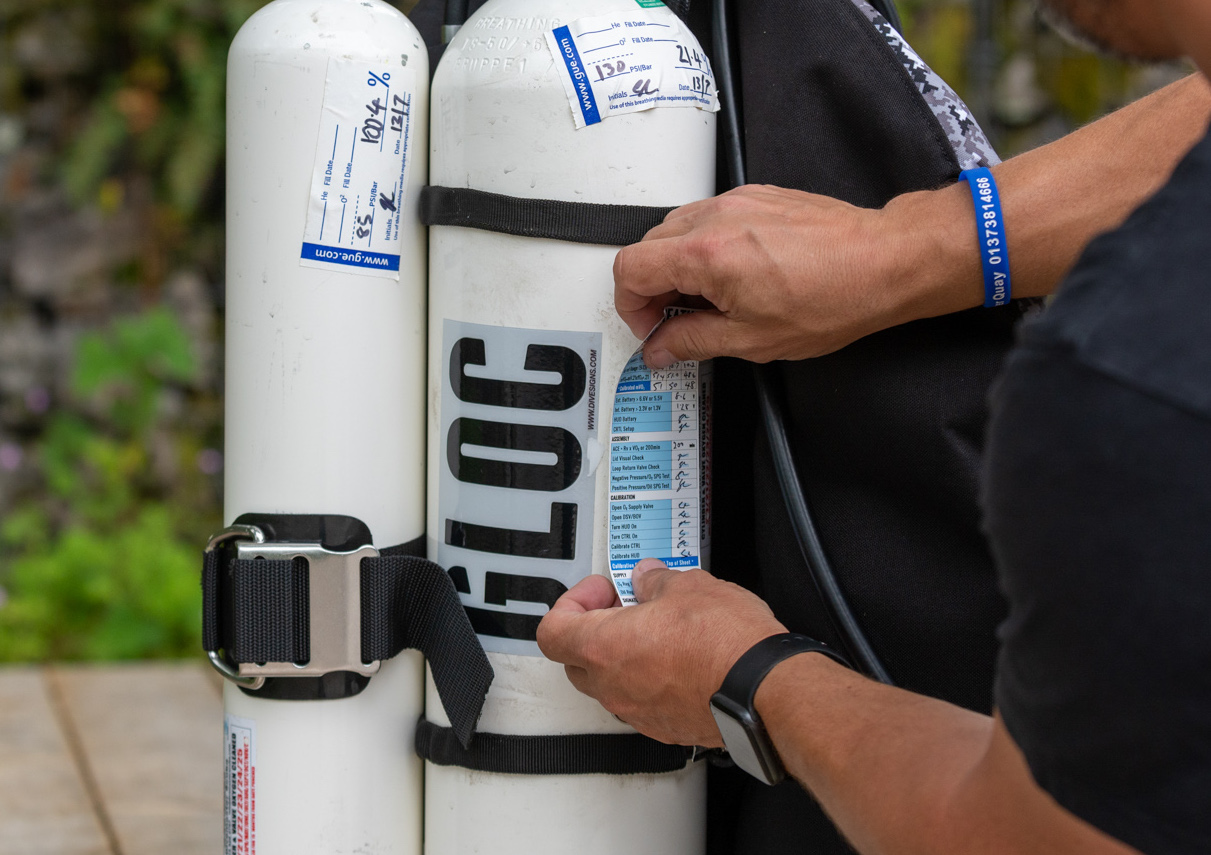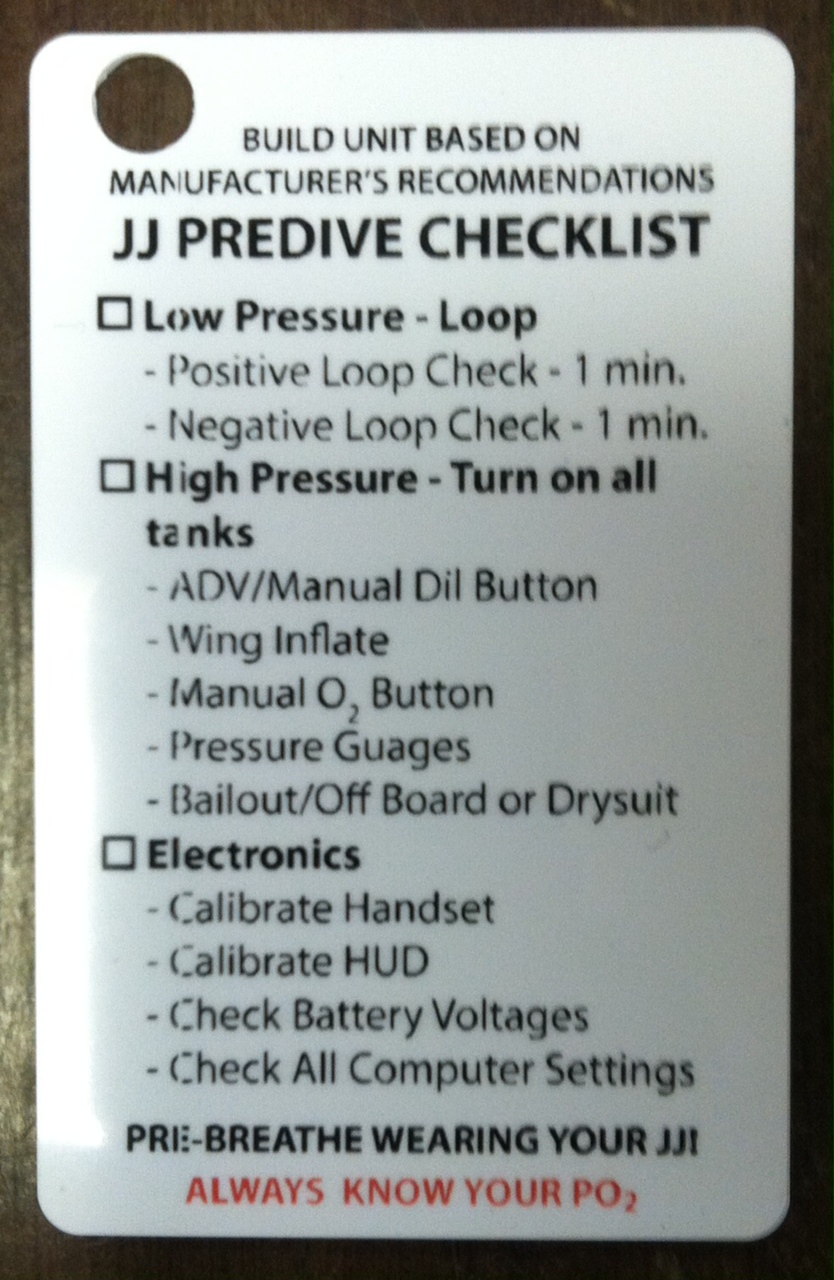
How to Improve Diving Checklist Design and Use - Part 2
Apr 23, 2023This blog follows a number of conversations that happened at Rebreather Forum 4 this week in Malta and concerns the need to design checklists with HF principles in mind for rebreather (and wider) diving.
Part 1 of the Checklist Blog is here although they are not directly linked as part 1 and part 2.
Aviation is often cited as the best place to look at when it comes to designing, deploying, and using checklists. The general use and design of the aircraft checklist may seem like a simple matter, however, there are many aspects to checklist design and how it can be used - many of those lessons which have been learned in aviation can be applied to the diving community.
The ‘Challenge and Response’ checklist method is the routine most used by commercial and military aviation operations. In this routine, the designated pilot calls out a checklist item (switch or lever). This is the ‘challenge’. The pilot who is responsible for that item responds by finding, grasping, and moving the item into the position called for and then confirming the configuration is as expected. It isn’t the action that is part of the checklist ‘response’ but rather the system response e.g., “gear down”, “down AND locked”.
Degani and Wiener (1990) remind us that from the human factors perspective, the checklist provides an interface between man and machine with the goal to:
- Help the pilot accurately configure the aircraft for flight phase.
- Provide a systematic method to verify the configuration, even if the crew is fatigued or stressed.
- Provide a systematic and convenient eye scan of cockpit panels.
- Provide a sequential framework to meet cockpit operational requirements.
- Provide a method of crew member cross-checking.
- Provide a systematic method of configuring the aircraft, keeping all crew/team members in the loop.
- Provide a method of optimum crew coordination and distribution of cockpit workload.
- Provide a quality control tool that can be used to evaluate pilots.
- Promote a positive attitude about checklist use and safety.
There are many parallels with the diving context. In most situations, you can replace pilot/crew with diver/dive team, and aircraft with dive equipment. Items 3, 7 and 8 have limited cross-over from aviation to diving given the way in which diving operations take place.
Reasons for Deviations from Checks

Distractions
Distraction is the most obvious reason for deviations from the checklist. When emergency or abnormal situations arise, the checklist can be forgotten or interrupted. Since checklist initiation is usually tied to external cues, the checklist is sometimes forgotten when these cues are missing, or are different e.g., if a checklist is normally done right before diving, but the dive entry is delayed, the configuration changes, but the assumption is the checklist is still valid.
Individualism
No matter how well-trained divers are, they are individuals and will impose that individuality on a procedure or checklist. In some cases, this individualism does not affect the safety or may even enhance safety. However, in other cases, safety is compromised. The bottom line here is that there exists the possibility of conflict between individualism and standardisation. Examples of where individuality and the flexibility of the human mind were useful, were in the Sioux City DC-10 accident and the ditching of Cactus 1549 on the Hudson River. In both cases, the crew had to improvise emergency procedures. In diving, there are few conditions in which the individual modification of checklists leads to a positive or innovative situation regarding safety.

Complacency
Many studies have shown that pilots can become complacent – why would divers be any different? This complacency is caused by the inherent physiological resilience of the human (mistakes don’t often lead to a fatality), the lack of reported incidents/near-misses so we recognise the presence of these outcomes, and the lack of adverse events in normal operations. This acceptance of shifting risk is made worse by fatigue and stress. Human factors researchers have noticed what they call automation complacency - this is a type of complacency in which the operator becomes too trusting of automation and believes that it will always work and will let them know it is no longer working properly.
Frustration
When a task or procedure is frustrating, divers tend to find ways to work around them. Degani and Wiener (1994) note the example of the oxygen mask. Oxygen masks are uncomfortable and hard to replace in their holders. Regulations require that when one pilot leaves the cockpit above 25,000 feet, the remaining pilot must put on an oxygen mask. Since this task is frustrating to the pilots, some will abandon the standard climb procedure and ask for a level-off at 25,000 feet until the other pilot returns to the cockpit. This non-standard procedure costs extra fuel and ties up the Air traffic Control (ATC) system. Diving examples could be about checking the date of oxygen cells on a rebreather prior to use, where they are not easily accessible and so they are beyond their useable date, or the ease by which you can get an oxygen analyser on a dive boat and so don’t analyse gas.

Design
Even though there have been some accidents in which checklist readability may have been a contributing factor, there is research which investigates checklist design including text formatting and readability. Checklist design is interesting in that few people can agree on a standard. Even after aircraft manufacturers spend much time and money developing checklists, the airlines that buy the aircraft frequently produce their own checklists changing everything from font, type and style, and paper colour to actual procedure sequences. These same challenges exist in the diving domain regarding checklist design.
Solutions to the Problem
Checklist Usage
There are several techniques that can be used to ensure that the checklists are used in an optimum manner. A checklist should be initiated by the designated crew member. This lessens the impact of distractions and reliance on another member's memory to self-initiate a checklist. If the designated initiator forgets, then the other member can say something like "Are you ready for the checklist?" Checklists should be initiated during times of low workload, if possible. For example, Degani and Wiener (1990) state that the taxi checklist should be accomplished as close to the gate as possible and as far from the active runway as possible. This is because the probability of completing the checklist becomes less and less as the aircraft gets closer and closer to the runway. In the context of diving, this could be about doing a final pre-dive check while walking from the bench to the gate on a boat, rather than sitting on the bench and doing a team check.
Interruptions
When a checklist is interrupted for any reason, the checklist should be stopped by the responding pilot. A good way to stop a checklist would be to say "stop it at flaps (or gear, etc)". This is referred to as an "explicit hold" on the checklist (Sumwalt, 1991). One simulator study of checklist interruption shows that explicit holds after an interruption can help a crew return to the checklist and complete it (Sumwalt, 1991). After a checklist has been completed, the challenging dive team member should announce that the checklist is complete. This emphasises the end of the checklist so that the team can move on to other tasks and not skip anything.

Checklist Design
In addition to the human factors issues associated with checklist usage, there are also human factors issues associated with checklist design. For example, if the print is too small, or the wording is not standardised, a checklist loses its effectiveness. The checklist should not contain words that are ambiguous. Degani and Wiener (1990) inspected several checklists and noted the usage of ambiguous terms such as set, check, and complete. Checklist nomenclature should always state the actual status or value of the item. In diving examples, these could be “SPG check” should be “Gas Pressure is…” and “pO2 check” should be “pO2 is 0.7” (or whatever the planned pO2 is). Checklists should use consistent, and standardised wording to allow error-checking.
Readability
Readability is a characteristic that allows the diver to rapidly recognise single words, word groups, abbreviations, and symbols. Degani says that readability depends on "the spacing of individual characters, spacing of words, spacing of lines, and the ratio of character area to the background area."

Conclusions
Aircraft accidents have occurred in the past in which misuse of the checklist was a factor. Unfortunately, there isn’t any conclusive data from the diving incident data to show the scale of the problem, but misconfigured equipment is likely to be a considerable contributory factor. These accidents and near-misses may have been avoided if more emphasis had been placed on checklist design, deployment and use in diving operations.
Checklists are an important aspect of aviation's system safety – they should be an intrinsic part of safe diving operations too. Checklists are just tools that need a social system for them to be used consistently. Deviations from checklists can be caused by distractions, individualism, complacency, and frustration. One way to minimise the effects of the above factors is to use a standard checklist routine in a consistent and methodologically-sound manner. The checklist should be initiated at the earliest possible time in the segment of operations e.g., the final pre-dive check should be completed before leaving the seated/final preparation location.
The dive team should keep in mind that abnormal situations can result in the absence of the usual checklist cues e.g., distractions during preparation or between configuring dive equipment and using it. Checklist design is a factor that should be considered by anyone developing a checklist. Font style and size and other type characteristics can have an impact on usability.
References:
Ross. Human Factors Issues of the Aircraft Checklist, 2004.
Degani, Asaf; Wiener, Earl L. (1990) Human Factors of Fight-Deck Checklists: The Normal Checklist. Contract No. NCC2-377. A report prepared for Ames Research Center.
Degani, A. and Wiener, E. L. (1994). On the Design of Flight-Deck Procedures. (NASA Contractor Report 177642). Moffett Field, CA: NASA-Ames Research Center.

Gareth Lock is the owner of The Human Diver, a niche company focused on educating and developing divers, instructors and related teams to be high-performing. If you'd like to deepen your diving experience, consider taking the online introduction course which will change your attitude towards diving because safety is your perception, visit the website.
Want to learn more about this article or have questions? Contact us.










